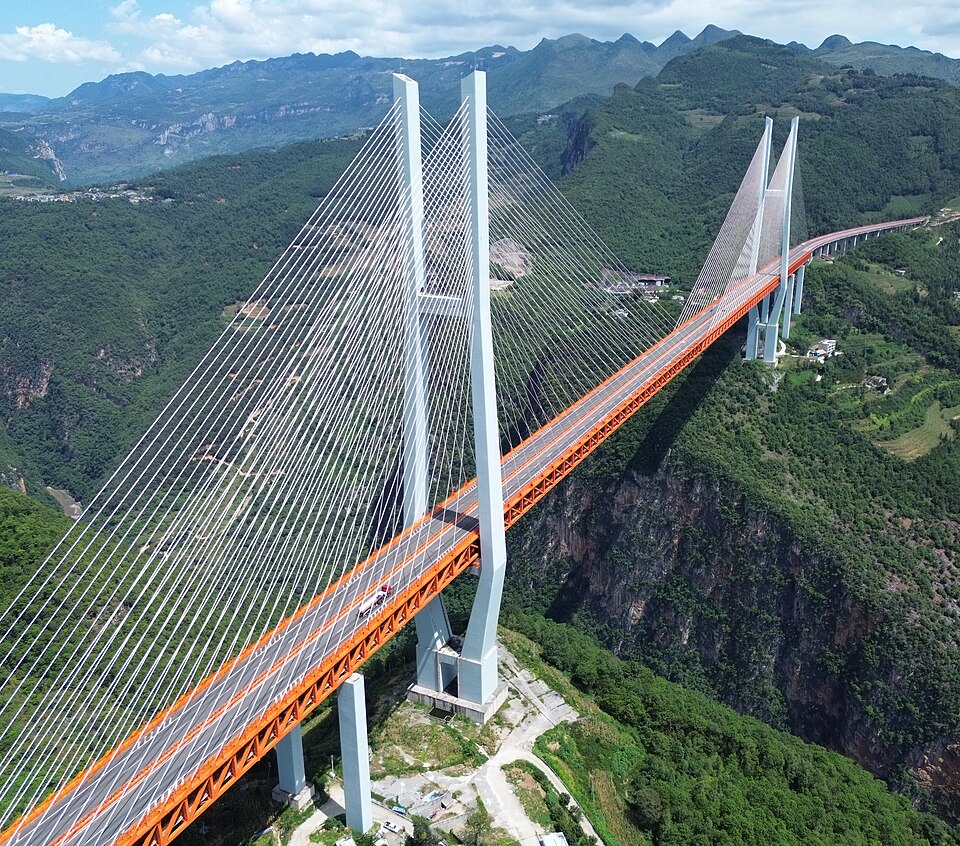The 2nd World’s Highest Bridge: Beipanjiang, China’s Record-Breaking Engineering Marvel in Guizhou
Suspended nearly a kilometre above a deep mountain gorge, the Beipanjiang Bridge in China stands as a breathtaking symbol of modern engineering mastery. More than just the world’s highest bridge, it represents China’s relentless pursuit of innovation, connecting remote highlands through daring design and construction ingenuity.
Defying Gravity: The Birth of an Engineering Legend
In the rugged mountains of Guizhou Province, a region once known for its isolated valleys and deep river gorges, China has achieved the extraordinary. The Beipanjiang Bridge, officially recognised as the world’s highest bridge, soars 565 metres above the Beipan River, taller than the Empire State Building.
This bridge is not merely a record-setter; it’s a testament to human ingenuity and precision engineering. Completed in 2016, the structure forms part of the Hangzhou–Ruili Expressway, transforming what was once a five-hour journey across mountainous terrain into a mere 90-minute drive.
For civil engineers, bridge designers, and construction enthusiasts, the Beipanjiang Bridge represents the pinnacle of modern infrastructure development in China, where cutting-edge materials, complex geotechnical design, and advanced construction techniques converge to conquer nature’s toughest challenges.

Engineering Genius Behind the Beipanjiang Bridge in China
The Beipanjiang Bridge’s engineering design and height make it one of the most technically demanding infrastructure projects in Chinese history. The bridge spans an impressive 1,341 metres, with its central span stretching 720 metres, an achievement possible only through a combination of cable-stayed and steel truss design.
Its deck hovers 565 metres above the Beipan River, making it the highest bridge deck in the world. To visualise this, imagine stacking two Eiffel Towers on top of each other; the deck would still rise above them.
Engineers faced a dual challenge:
- The geological complexity of Guizhou’s deep limestone valleys.
- The extreme height and wind conditions over the Beipan River Canyon.
To overcome these, the bridge’s design team employed a four-tower, double-span suspension structure, using ultra-high-strength steel cables to maintain stability under varying loads and crosswinds reaching up to 80 km/h.
The project involved collaboration between the China Communications Construction Company (CCCC) ’s Highway Consultants Co. Then, the bridge was built by CCCC’s Second Harbour Engineering Company. The two companies combined traditional civil engineering with emerging digital modelling tools, which are a hallmark of engineering marvels in China.
How China Built the World’s Highest Bridge
Constructing the world’s highest bridge at such an extreme height demanded both creativity and courage. The Guizhou bridge construction process unfolded in stages that showcased the full spectrum of modern bridge engineering.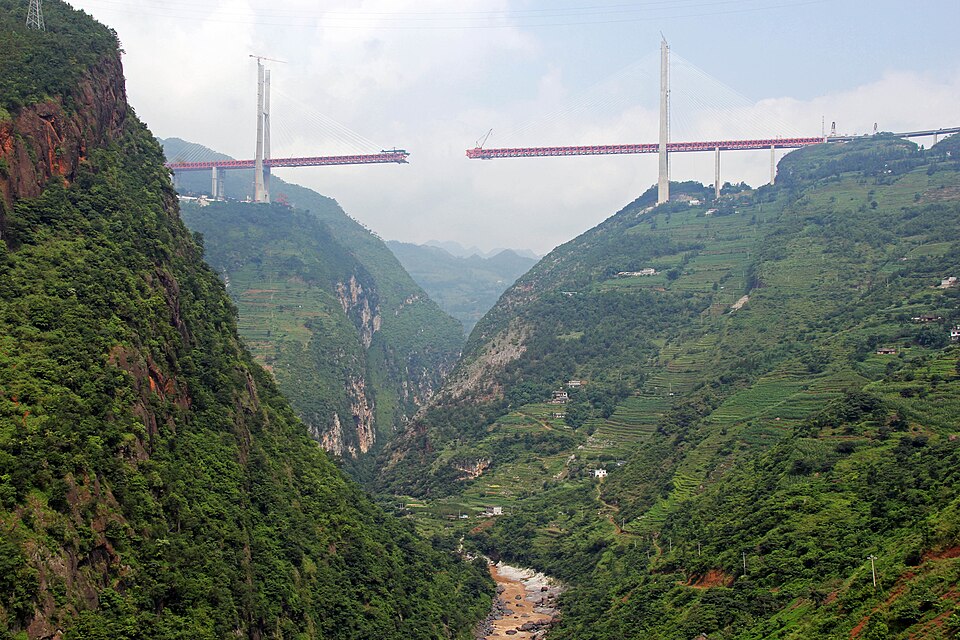
1. Surveying and Site Preparation
Engineers began with 3D topographic scans and geological surveys to analyse the steep terrain. The Beipanjiang Gorge presented a unique challenge: unstable rock layers and shifting fault lines. Special foundation anchoring systems were designed to counteract these geotechnical risks.
2. Tower Construction
Four concrete towers, each standing over 200 metres tall, were built on opposite sides of the gorge. Precision GPS and laser-guided systems were used to ensure perfect alignment; even a deviation of a few millimetres at that scale could lead to catastrophic structural imbalance.
3. Cable Installation
Instead of using cranes, they used drones and cable trolleys to string the first pilot lines across the canyon, a revolutionary technique that minimised risk to workers. These lines later supported the main cables that would hold the steel truss deck.
4. Deck Assembly
Sections of the steel deck were prefabricated off-site, then lifted into position using synchronised winches. Engineers used incremental launching, sliding deck segments across suspended cables to connect both ends. This minimised time and improved safety in one of the world’s deepest valleys.
5. Final Alignment and Load Testing
Upon completion, the bridge underwent rigorous dynamic load testing. Engineers simulated wind, traffic, and seismic conditions to ensure performance under real-world stresses. The final deflection recorded during testing was less than 15 cm, a remarkable precision for a structure spanning over a kilometre.
Record-Breaking Bridge Construction in China: Pushing the Limits of Engineering
The Beipanjiang Bridge, also known as the “Duge Bridge”, is part of China’s ongoing drive to link its western provinces with coastal economic zones. Yet, beyond its transportation function, it has become a symbol of engineering audacity and a benchmark for the tallest bridges in the world.
China now dominates global bridge engineering, with eight of the world’s ten highest bridges located within its borders. What sets these projects apart is not just scale, but technical innovation from high-altitude concrete pumping systems to intelligent monitoring sensors that transmit real-time structural health data.
The Beipanjiang Bridge’s success has inspired similar mega-projects in Guizhou Province, including the Pingtang Bridge and the Liuguanghe Bridge, further positioning the region as a global hub for advanced civil engineering.
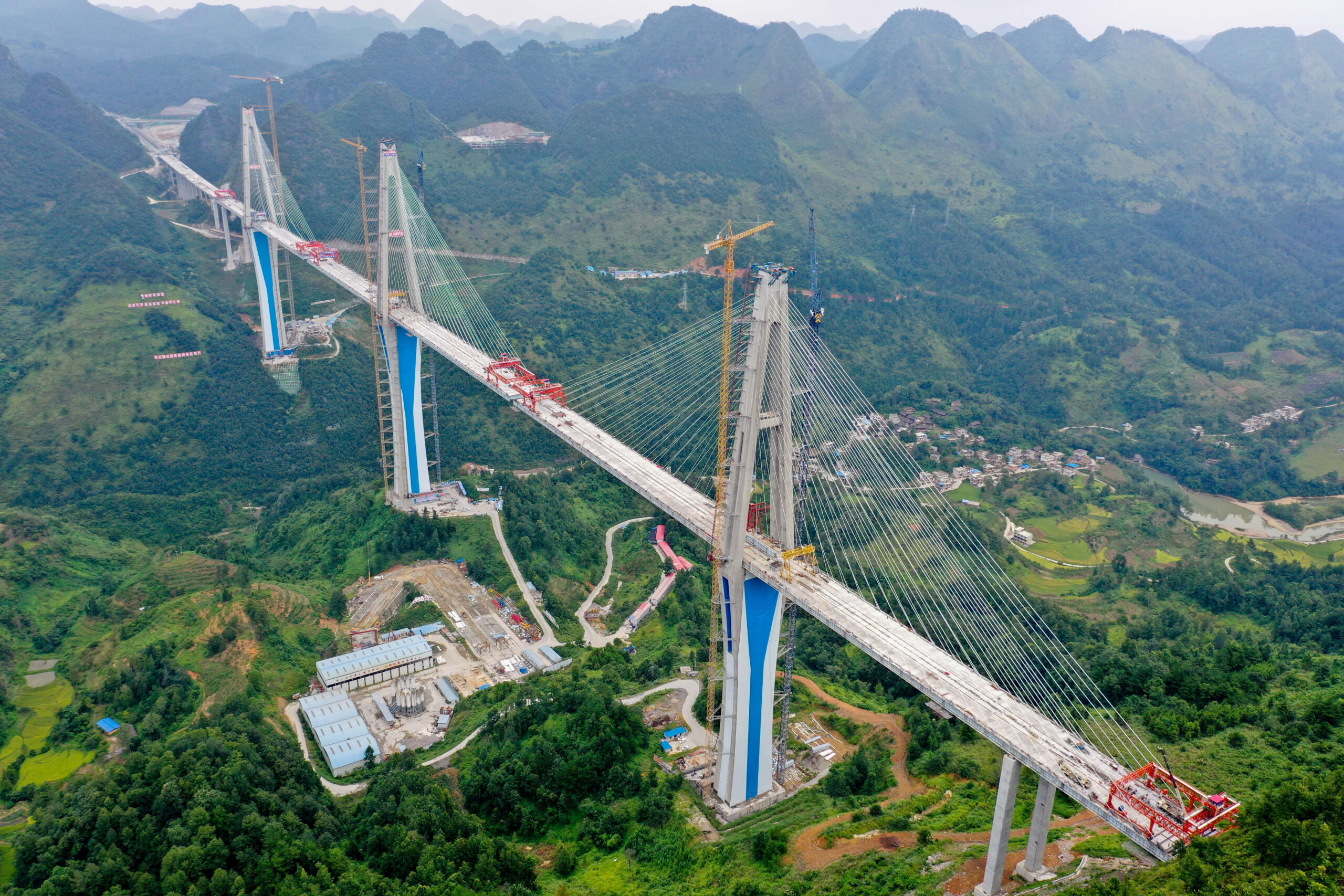
Pingtang Bridge (305 m high) in Pingtang, Guizhou, China
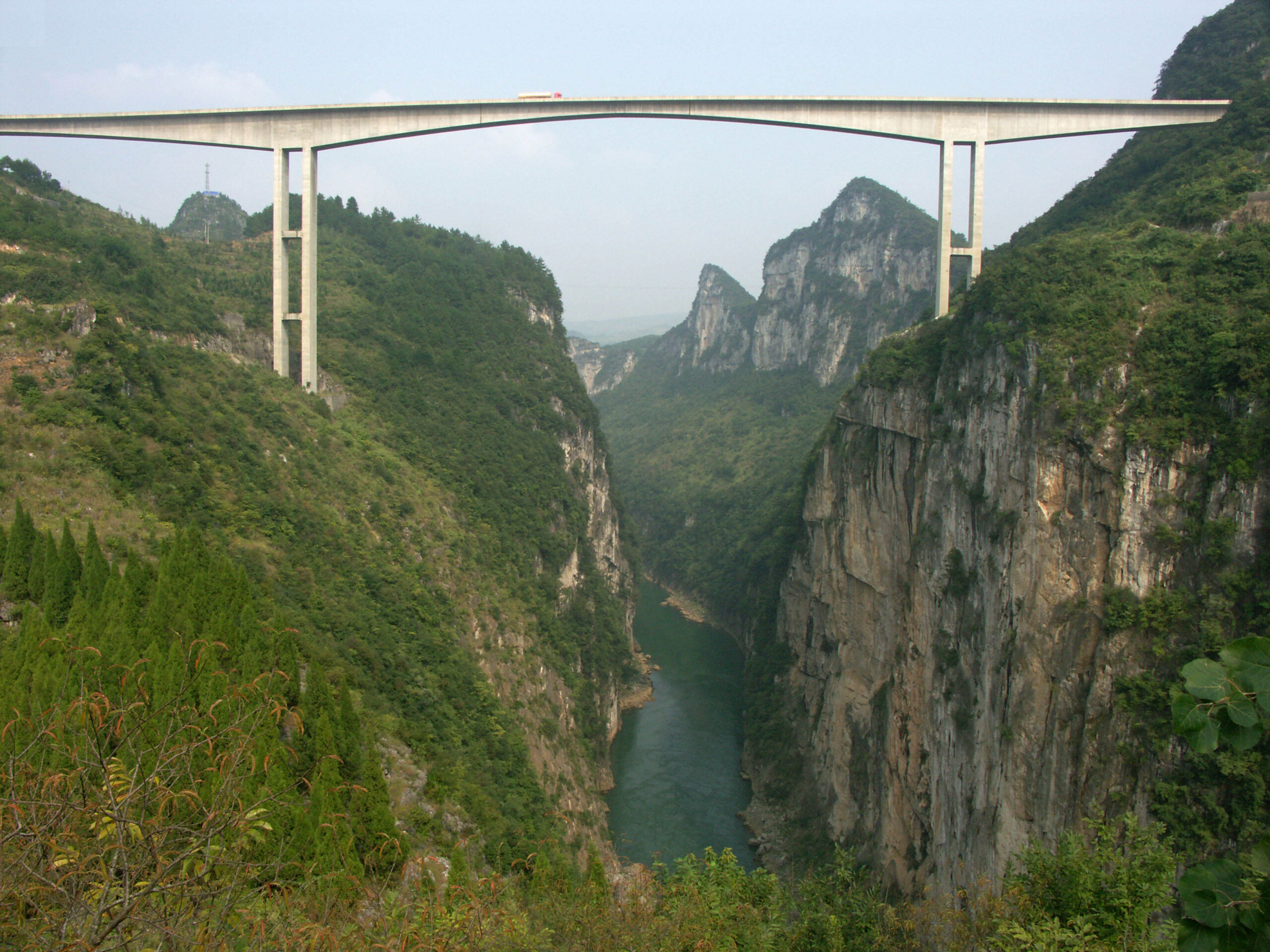
Liuguanghe Bridge (297 m high) in Liu Guangzhen, Guizhou, China
Engineering Innovations that Made It Possible
China’s bridge builders are redefining how we think about large-scale infrastructure. The Beipanjiang Bridge incorporates several cutting-edge technologies that have since become industry benchmarks:
- Wind-Resistant Cable Systems: Advanced aerodynamic modelling allowed engineers to design cable stays that minimise oscillation even under typhoon-level gusts.
- High-Performance Steel: The deck uses Q420-grade steel, offering an exceptional strength-to-weight ratio and corrosion resistance essential for Guizhou’s humid, high-altitude climate.
- Real-Time Structural Health Monitoring (SHM): Over 200 sensors track strain, vibration, and displacement, feeding live data to engineers for predictive maintenance.
- Anti-Fatigue Deck Design: The bridge deck features double orthotropic steel plates, reducing vibration-induced fatigue from heavy traffic loads.
These innovations not only set new standards for record-breaking bridge construction in China but also influence future major infrastructure projects in Guizhou Province and beyond.
Overcoming Construction Challenges in Guizhou’s Mountainous Terrain
Building the world’s highest bridge over one of China’s deepest valleys presented countless challenges, from unpredictable weather to limited access roads. Every logistical task required extraordinary precision.

- High-Altitude Work Safety: Workers operated at dizzying heights, requiring harnesses, weather sensors, and anti-slip platforms designed for strong wind conditions.
- Limited Access: Materials and equipment had to be airlifted or transported via narrow mountain roads, demanding careful logistical planning.
- Temperature Fluctuations: The canyon’s steep gradient created temperature differences exceeding 25°C between the deck and valley floor, affecting steel expansion and concrete curing rates.
- Seismic Design Considerations: Guizhou lies in a moderate earthquake zone, so engineers designed flexible joints and energy-absorbing dampers to ensure long-term resilience.
Through a combination of precision engineering and adaptive design, these obstacles were transformed into learning opportunities that shaped China’s future approach to high-altitude infrastructure.
A Global Benchmark: The Beipanjiang Bridge’s Influence
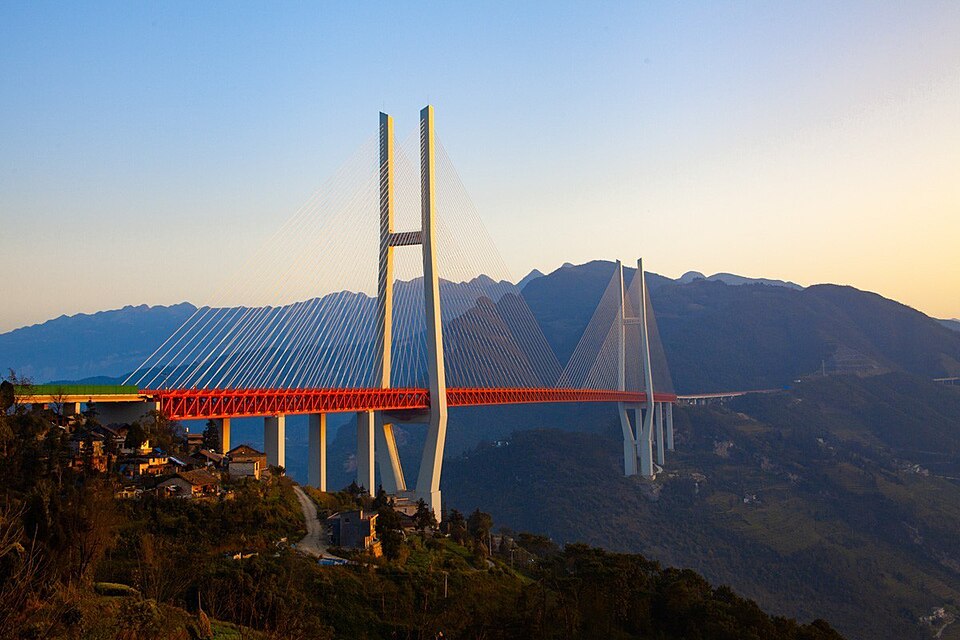
Today, the Beipanjiang Bridge is more than an engineering achievement; it’s an educational case study for bridge designers and civil engineering professionals worldwide. Universities and research institutions study its design to advance knowledge in aerodynamics, material science, and construction management.
Its success highlights how infrastructure development in China combines state-backed investment with private-sector innovation to produce global leadership in megastructure construction. For engineers, it’s a reminder that technology and terrain can coexist, that even the world’s most challenging environments can yield to the will of human design.
Conclusion: Redefining What’s Possible in Bridge Engineering
The Beipanjiang Bridge isn’t just the world’s highest bridge; it’s a living symbol of what determined engineering can achieve. From conceptual design to completion, every phase reflects a fusion of courage, precision, and scientific innovation.
As Guizhou bridge construction continues to push the limits of height and complexity, China is proving that geography is no longer a barrier to progress. For construction professionals and engineers worldwide, the Beipanjiang Bridge serves as a masterclass in engineering vision turned reality.
Call to Action: Building the Future, One Marvel at a Time
At ConstructionFrontier.com, we celebrate the projects that reshape our world, from the tallest bridges in the world to the next frontier of sustainable construction. Stay ahead with in-depth analyses, engineering insights, and groundbreaking innovations shaping global infrastructure.

